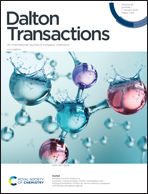Facile hydrogen atom abstraction and sulfide formation in a methyl-thiolate capped iron–sulfur–carbonyl cluster†
Abstract
The interest in methyl group C–H bond activation near or bound to iron-containing clusters is of key biological importance, due to the broad relevance of radical SAM reactions. Specifically, such processes are implicated in the biogenesis of the interstitial carbide found in the nitrogenase FeMoco active site. In this work, we find that the diamagnetic, methyl-thiolate capped iron–carbonyl cluster anion [(CH3S)Fe3(CO)9]− (1) undergoes facile C–H hydrogen atom abstraction upon treatment with TEMPO. The process leads to (i) eradication of the CH3 moiety, (ii) formation of a sulfide bridge, and (iii) cluster dimerization—thereby generating the ‘dimer of trimers’ cluster [K(benzo-15-crown-5)2]2[(SFe2(CO)12)2Fe(CO)2] (2). In contrast, the corresponding isopropyl variant [Fe3(SiPr)(CO)9]− (3) does not react with TEMPO. Mass spectrometry confirmed the presence of TEMPOH, as well as CO oxidation vis a vis CO2 and 2,2,6,6-tetramethylpiperidine. GC-MS measurements of the headspace reveal that the ultimate fate of the methyl carbon is likely incorporation into multiple products—one of which may be a volatile low mass hydrocarbon—rather than carbon/carbide incorporation.



 Please wait while we load your content...
Please wait while we load your content...
